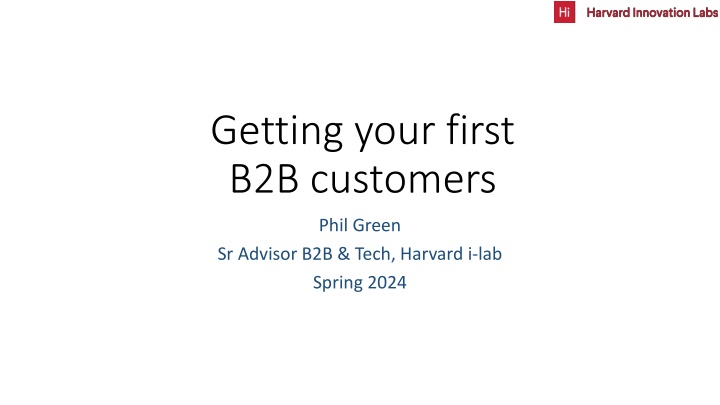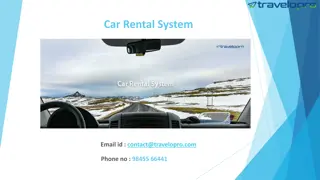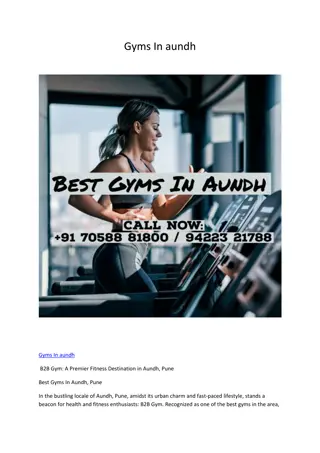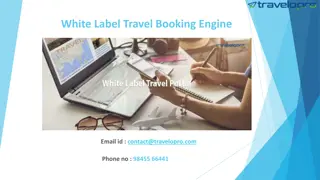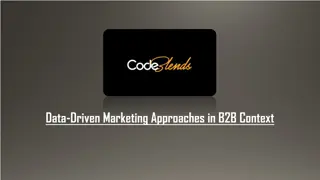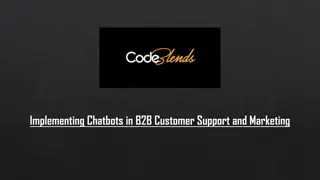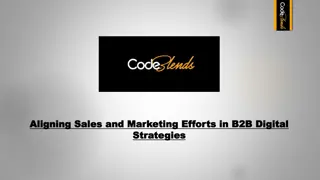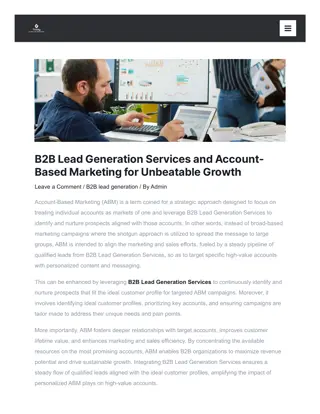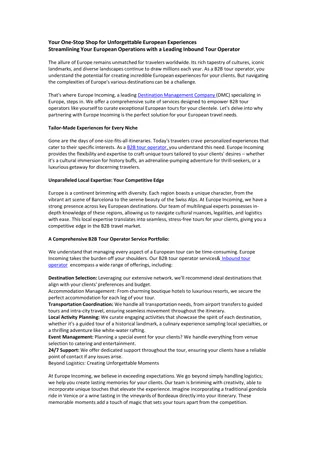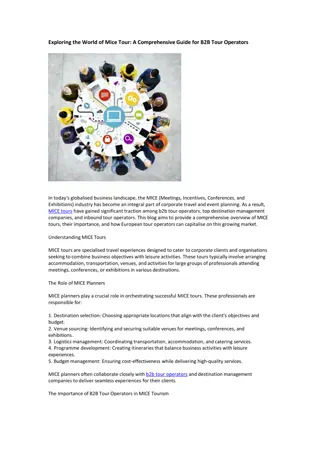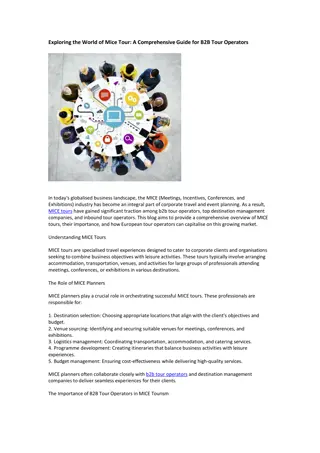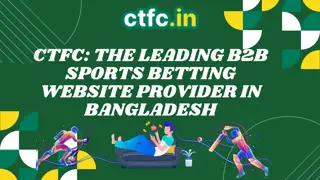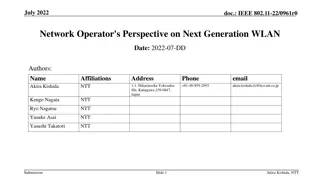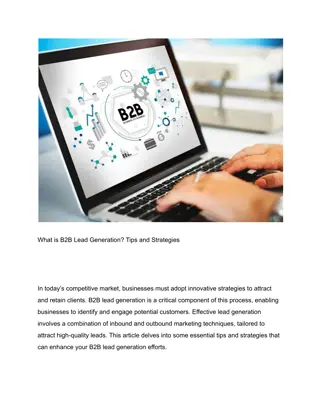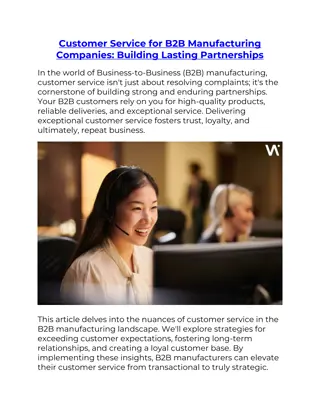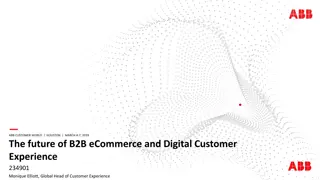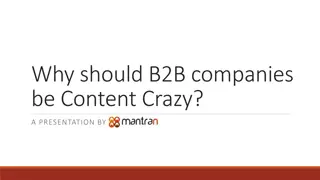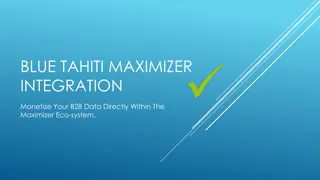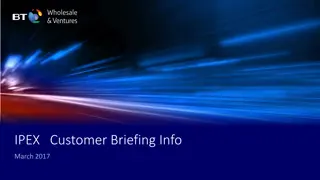How to Secure Your First B2B Customers: Practical Steps
Discover the essential steps to secure your first B2B customers, from conducting research and customer discovery to building MVPs and validating your solutions. Learn valuable insights on cultivating the right mindset and understanding your customers' needs better than they do. Follow a structured approach to reaching out to potential clients, identifying urgent needs, and ensuring your solution meets their pain points. This comprehensive guide provides actionable strategies for B2B success.
Download Presentation

Please find below an Image/Link to download the presentation.
The content on the website is provided AS IS for your information and personal use only. It may not be sold, licensed, or shared on other websites without obtaining consent from the author.If you encounter any issues during the download, it is possible that the publisher has removed the file from their server.
You are allowed to download the files provided on this website for personal or commercial use, subject to the condition that they are used lawfully. All files are the property of their respective owners.
The content on the website is provided AS IS for your information and personal use only. It may not be sold, licensed, or shared on other websites without obtaining consent from the author.
E N D
Presentation Transcript
Getting your first B2B customers Phil Green Sr Advisor B2B & Tech, Harvard i-lab Spring 2024
Mindset Thinking to avoid My tech is cool Everyone will want it They just need to see it Build it and they will come Thinking to cultivate Customers understand their problems better than you do Customers want to solve their problems. They do not want to buy your product.
Agenda: Getting your first Customers Secure first customers / pilots Customer discovery Build MVP Customer Validation / Pivots (iterate until customers stick around and pay)
Four steps to secure your Four steps to secure your first customers first customers
Research Find target customers on Linkedin Reach out to them "Hi I am a student at Harvard doing research in {the area of your venture} and I was hoping we could meet for 15 minutes." Keep the conversation to 15 mins. Use Mom test techniques DO NOT SELL YOUR PRODUCT End with "Thank you for your time. I am talking to lots of other companies, can we follow-up in a few weeks and I can provide a summary of how other folks just like you are solving some of the problems we discussed."
What you want to learn What problem(s) are they willing to pay you to solve Four sub-questions oIs there a problem? oDo they know they have a problem? oAre they looking for a solution? oDo they have the budget for a solution?
What else you need to think about What type of customer has the most urgent need? And which has little need right now? Segment the customers you speak to into groups (size, geography, etc.) and try to identify what is similar about the customers with the most urgency Focus more time talking to customers that have: High urgency / high priority Budget to spend on a solution Low barriers to adoption
How well does my solution solve their pain? Perfectly (unlikely) Do you need minor adjustments? Do you need a major pivot? Adjust as necessary continue to do Research or proceed to step #2
Step 2: Confirmation
Confirmation Reach back out to the customers that had the highest need and seemed easiest to work with Let them know what you found out: Thank you for speaking to me earlier, today I d like to confirm what I thought I heard you say and let you know what the other people doing your job at other companies said. Goal confirm that you understand a major pain point and ensure that your offering is a desired solution to that problem
Testing your solution I heard several other people say they solve their problem by doing {this}. What do you think about that? I heard several other people say that they are looking to buy a product that did {this}. Does that seem right to you? Do not say we built {this} do you want one?
Soft close Close with: Based on what we heard from you and lots of other companies, we think we can build something to help you solve that problem. Can we talk in a few weeks about a solution we are thinking about?
Step 3: Trial / Validation
Trial / Validation Call the MOST receptive customers from step 2 and introduce the solution. Focus on how it solves the issue you uncovered during the research. Offer a VERY LOW FRICTION way for the customer to try it. (e.g. free or offer to accept payment for continued use if they like it) This should be an MVP (better yet a concierge MVP fully manual) Goal - to validate that: a) The customer is interested in your solution b) You know how to solve the problem
Stickiness true validation Almost all problems occur over time and require an ongoing solution. So don t worry about not getting paid for the first-time use. Do they want to continue to use it? If NO, either Offer to do it again, as long as they can tell you exactly why your solution did not meet their requirements. (Then tweak the MVP / manual process to suit their needs) Repeat until they are raving fans Go back to Step 1: Research -> gain a better understanding of what the customer requires If they are very happy, proceed to Step 4
Breakout conversion Describe a fully manual solution you could offer you target customers
Step 4: Close your First Sale
Close your First Sales Pricing is an Art How much money does this save the customer? How much revenue does this create for the customer? What is the price of competitive products? What is the price of the suite of products that the customer uses that are somewhat similar to your product? Ask the customer to pay for continued use of the product. If they won t pay, either: Offer to do it again, as long as they can tell you exactly why your solution did not meet their requirements. (Then tweak the MVP / manual process to suit their needs) Repeat until they are raving fans and will pay Try to determine if this customer really has an urgent need, if not, find another customer Go back to Step 1: Research -> gain a better understanding of what customers require
A few closing points
Dont overbuild the MVP When you have a lot invested in the MVP, you have a lot of ego invested in its success If the MVP is not easily changed, then you can t adjust it to suit the customer needs in real time and you will lose the customer MVP advice Start with a concierge MVP (fully manual) and learn how to solve the problem the customer is willing to pay for Automate the most labor-intensive part and get customer #2, validate that they also love it Then automate the next labor-intensive parts and get customers #3 & #4 Repeat until its fully automated (finished app / offering) and scale the customer base
Sample MVPs Amazon: built a static web site of books, offering them at a lower price than the local bookstore, and then buying books from distributors and shipping them DoorDash: made a static HTML page with a Google Voice number and a few PDF menus from local restaurants, offering delivery for $6 Airbnb: started as an ad about renting an air bed in a spare bedroom
Dont think: They just don t understand my product. They just don t understand my product. Customers don t care about your product They want their problems solved And if they won t buy it, it is because they don t want it or it does not provide enough value for them Focus on solving their problem, NOT your product / offering
